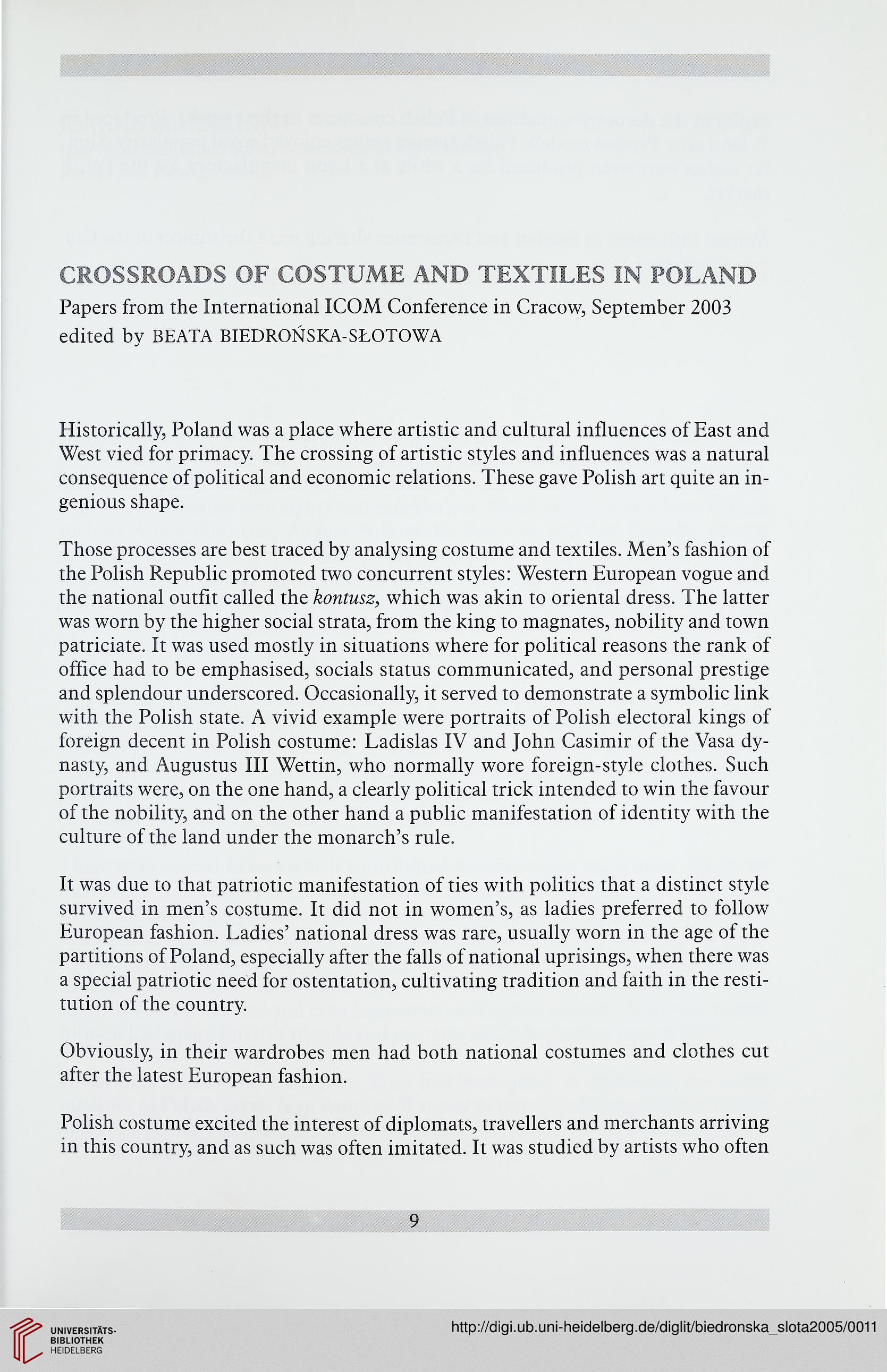CROSSROADS OF COSTUME AND TEXTILES IN POLAND
Papers from the International ICOM Conference in Cracow, September 2003
edited by BEATA BIEDROŃSKA-SŁOTOWA
Historically, Poland was a place where artistic and cultural influences of East and
West vied for primacy. The crossing of artistic styles and influences was a natural
conseąuence of political and economic relations. These gave Polish art quite an in-
genious shape.
Those processes are best traced by analysing costume and textiles. Men's fashion of
the Polish Republic promoted two concurrent styles: Western European vogue and
the national outfit called the kontusz, which was akin to oriental dress. The latter
was worn by the higher social strata, from the king to magnates, nobility and town
patriciate. It was used mostly in situations where for political reasons the rank of
office had to be emphasised, socials status communicated, and personal prestige
and splendour underscored. Occasionally, it served to demonstrate a symbolic link
with the Polish state. A vivid example were portraits of Polish electoral kings of
foreign decent in Polish costume: Ladislas IV and John Casimir of the Vasa dy-
nasty, and Augustus III Wettin, who normally wore foreign-style clothes. Such
portraits were, on the one hand, a clearly political trick intended to win the favour
of the nobility, and on the other hand a public manifestation of identity with the
culture of the land under the monarch's rule.
It was due to that patriotic manifestation of ties with politics that a distinct style
survived in men's costume. It did not in women's, as ladies preferred to follow
European fashion. Ladies' national dress was rare, usually worn in the age of the
partitions of Poland, especially after the falls of national uprisings, when there was
a special patriotic need for ostentation, cultivating tradition and faith in the resti-
tution of the country.
Obviously, in their wardrobes men had both national costumes and clothes cut
after the latest European fashion.
Polish costume excited the interest of diplomats, travellers and merchants arriving
in this country, and as such was often imitated. It was studied by artists who often
9
Papers from the International ICOM Conference in Cracow, September 2003
edited by BEATA BIEDROŃSKA-SŁOTOWA
Historically, Poland was a place where artistic and cultural influences of East and
West vied for primacy. The crossing of artistic styles and influences was a natural
conseąuence of political and economic relations. These gave Polish art quite an in-
genious shape.
Those processes are best traced by analysing costume and textiles. Men's fashion of
the Polish Republic promoted two concurrent styles: Western European vogue and
the national outfit called the kontusz, which was akin to oriental dress. The latter
was worn by the higher social strata, from the king to magnates, nobility and town
patriciate. It was used mostly in situations where for political reasons the rank of
office had to be emphasised, socials status communicated, and personal prestige
and splendour underscored. Occasionally, it served to demonstrate a symbolic link
with the Polish state. A vivid example were portraits of Polish electoral kings of
foreign decent in Polish costume: Ladislas IV and John Casimir of the Vasa dy-
nasty, and Augustus III Wettin, who normally wore foreign-style clothes. Such
portraits were, on the one hand, a clearly political trick intended to win the favour
of the nobility, and on the other hand a public manifestation of identity with the
culture of the land under the monarch's rule.
It was due to that patriotic manifestation of ties with politics that a distinct style
survived in men's costume. It did not in women's, as ladies preferred to follow
European fashion. Ladies' national dress was rare, usually worn in the age of the
partitions of Poland, especially after the falls of national uprisings, when there was
a special patriotic need for ostentation, cultivating tradition and faith in the resti-
tution of the country.
Obviously, in their wardrobes men had both national costumes and clothes cut
after the latest European fashion.
Polish costume excited the interest of diplomats, travellers and merchants arriving
in this country, and as such was often imitated. It was studied by artists who often
9





